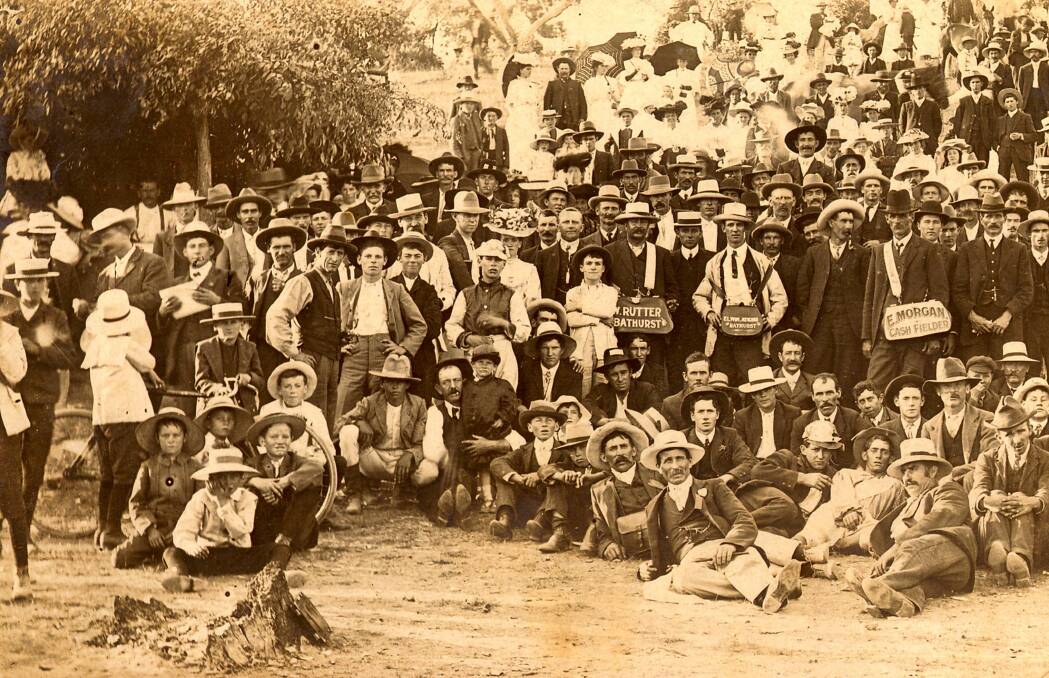
OUR photo this week concerns Mr W.P. Rutter's Fast Coaches that operated between Burraga and Bathurst around federation and later. This is part two of his story. Our image shows a race meeting held at Burraga around 1908. Mr Rutter, who can be seen in the centre, has "W. Rutter Bathurst" on his leather bag. There are two others who are obviously involved in betting on the day: Elwyn Atkins and E. Morgan, Cash Fielder, both of Bathurst.
Mr Rutter, who had an interest in and knowledge of all types of horses, was a member of the Bathurst Horse Race Club. The club held a race meeting in Bathurst in March 1905 on its new course and there was a good attendance of 1200 to 1500. The racing was exceptionally good, there being some exciting finishes.
Subscribe now for unlimited access.
$0/
(min cost $0)
or signup to continue reading
In the Handicap Hack Race, the five sovereign prize went to Mr W. Rutter's Oriel.
Mr Rutter had been associated with horse racing in Bathurst as early as 1875.
In April 1875, he was a steward for the Bathurst Annual Races that were held over several days. The club's patron was His Excellency Sir Hercules Robinson and Mr J. Rutter was the chief judge.
Another advertisement in February 1910 informed patrons that Rutter's Fast Coaches would leave Sloane's Hotel in Bathurst, for Rockley, on Tuesdays, Thursdays and Saturdays at 9am. The advertisement said fares were reasonable and Mr W.P. Rutter was so favourably known that his line of coaches needed no recommendation to the travelling public.
IN NEWS AROUND BATHURST:
The condition of the road to Burraga seemed to be a subject in the newspapers of the time. On October 27, 1899, the editor of the Bathurst Free Press received some correspondence from Gerhard A. Stockfeld, general superintendent of Lloyd's Copper Co, Limited, in Burraga.
"The alteration which is being made to the Bathurst to Burraga road at the 15 mile peg is a strange proceeding. In view of the fact that there is so much work that is absolutely necessary on other parts of the road which, up to the present, are not being touched," Mr Stockfeld wrote.
"The grade at the 15 mile peg is at best but short 'pinch' and there are lots of worse ascents all along the track. If those who have the direction of affairs really wish to improve the road, why not start on the places which require immediate attention, and not on a spot which never has, up to date, proved any inconvenience to anyone.
"The carriers, the real judges of the state of the road, as they are the people who have to contend with the difficulties, and not the ordinary casual traveller, ridicule the work that is being done, and would much rather see a party metalling the red hill at the 35 mile peg.
"About September, 1897, the cutting on the Red Hill was being made, but not an ounce of metal has ever been put on it, and in wet weather it is a veritable glue-pot.
"My company is spending a large sum of money at Burraga, and since I took charge of the mine the population of Burraga has more than doubled.
"A lot of heavy machinery will shortly have to pass over the road, and the state of the culverts and bridges is very doubtful.
"If the road authorities want to do some good work which will benefit the community, and not throw money away on useless gilt-edging, let them make a decent approach to Sophy's Creek, metal the ascent from the Judd's Creek Post Office, and put men on at the 33, 35 and 37 mile pegs, and from there to Burraga, where it is really wanted."

